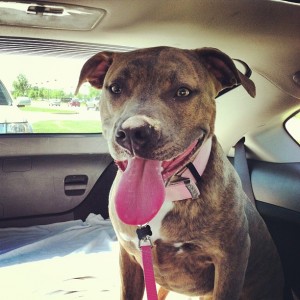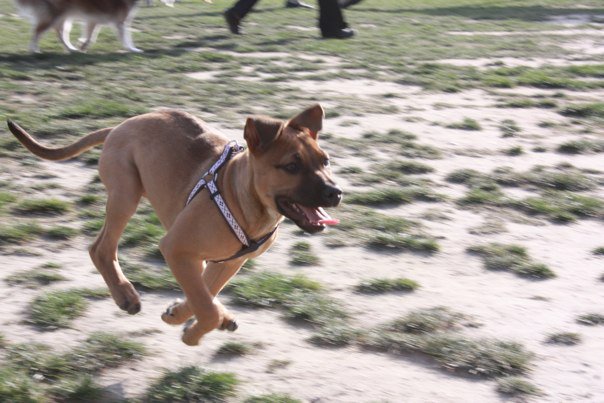C.T. Brady is a Brittany who will be 13 on Christmas 2013. He was born with a crooked spine (his short tail is canted severely to the left; the C.T. is for “Crook Tail”) and he has very straight stifles (or rear knees) in his hind end. He’s always had a funky gait and the tendency to dislocate his right hind. When he was 7 weeks old he was kicked by a horse, breaking his front “elbows’. They were repaired with titanium plates at the nearby vet school hospital ($7200). Since this injury was exceptionally painful and occurred during a sensitive developmental period of puppy-hood, Brady has since been very wimpy about pain and terrified of vets. He’s not at all stoic like my other dogs and I have to be extra vigilant that he doesn’t manipulate me to baby him when he whimpers or cries.
My vet told me when he was a puppy the best thing I could do for his joints was lots of exercise but warned that he would probably develop arthritis and could have problems with his stifles. I walk my dogs every day in off-leash areas so they get to run. Brady is high energy and has lots of stamina. Being off-leash is his joy. This past year he’s gotten stiff and can no longer jump on the bed or into the truck without a lift. But once free he’s like a young dog again and runs and runs. Throughout his life, mostly in the cold weather, his right hind would suddenly ‘dislocate’. He’d hold the leg up and hop along as though nothing had happened – so apparently there was no pain. Sometimes it would ‘right’ itself and sometimes I’d call him to me and massage the leg and then he’d run off and the leg would be fine. I always told my vet. She said not to worry unless he showed pain.
This past May 2013, Brady was loping past me on a walk over uneven terrain. Suddenly he yelped and was holding up his right hind leg. This time it didn’t right itself on its own or with massage. Brady was trembling, panting and didn’t want to continue. He hobbled with me back to the truck and cried when the other dogs jostled him. I called the vet and she said to give him an aspirin and to call the next day if he was still in pain. He was; I called vet and made arrangements to bring him in. She diagnosed a ruptured CCL (cranial cruciate ligament) based on the ‘drawer movement’ and, later, with x-rays. She told me the only true fix was surgery; that there were different surgical options and that all of them were ‘serious’ in that the recovery time would be lengthy. She also said there was a significant probability of recurrence due to his history as well as the chance he would rupture the ligament on the left side.
Given his history, age and temperament, I did not want to put him through surgery. Being retired I also didn’t need the expense. But I also did not want him to be in pain. My vet said I had time to think about it. She said we could wait and see for a few days or even weeks or months, depending on how Brady did. She gave me some ‘bute’ for pain and we made an appointment for three weeks later. She told me to continue walking the dogs as usual – just to let Brady decide how much and how far.
Brady always, always wanted to go for a walk off leash. The bute helped his initial pain, though I must say I worried it would mask it enough that he might hurt himself more. But he carried his injured leg up and loped along happily. It was harder for him to go slower at a walk or trot, because then he would have to limp. It reminded me that there are many happy three-legged dogs in the world, as well as those who have only two and must use wheeled carts as prostheses. The main concern I had was that he be comfortable.
After three weeks Brady was weaned off the bute. His leg was still unstable and the thigh was swollen but he was not exhibiting any signs of pain – except when his boisterous ‘sister’ would roughhouse too hard – which was nothing new. I told the vet I wanted to continue this “conservative, wait-and-see” approach. She said she would support it. She said some dogs develop enough scar tissue that the joint gets somewhat stabilized. She cautioned that things could get worse at any time.
It’s now been a little over 3 months since the rupture. Brady continues to show no pain (except the overall stiffness on rising that he showed for almost a year prior to the ligament injury). We continue our long walks and swims. We do lots of hills. I let him set the pace and distances. He is now using the injured leg more; actually putting it on the ground and pushing with it when he lopes. He has much less of a limp when he trots and none when he walks. His thigh is still a bit swollen and his leg will give out on him sometimes when he goes to pivot on it – but he just looks surprised when this happens. He doesn’t cry out like he used to when the injury first happened. He jumps down from my truck just fine and can manage the stairs in my 2 story house.
So far, so good! I do give him Cosequin joint supplement tablets now and bought him an orthopedic bed though he prefers to climb (albeit slowly) onto the couch. Maybe it’s a matter of pride for him!
I do unto my animals as I would have done for myself. I tore my own anterior cruciate ligament 14 years ago. I opted for surgery because it could be done arthroscopically with local anesthesia and I could be back to normal in 2 days with care. If I had had to be laid up for months and do rehab I would have opted for putting up with a gimpy knee that didn’t hurt that much. Brady would be devastated if he couldn’t come with the other dogs and me on the daily hikes. So would I. Sadly, that day will come soon enough as he ages.
Each case (and dog) is different. As long as I can keep my animals comfortable and happy I will try to do without the stress of surgery or of being kenneled and left behind.
Will update this post in a few months.

